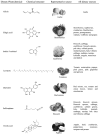Use of dietary phytochemicals to target inflammation, fibrosis, proliferation, and angiogenesis in uterine tissues: promising options for prevention and treatment of uterine fibroids?
- PMID: 24976593
- PMCID: PMC4152895
- DOI: 10.1002/mnfr.201400134
Use of dietary phytochemicals to target inflammation, fibrosis, proliferation, and angiogenesis in uterine tissues: promising options for prevention and treatment of uterine fibroids?
Abstract
Uterine leiomyomas (fibroids, myomas) are the most common benign tumors of female reproductive tract. They are highly prevalent, with 70-80% of women burdened by the end of their reproductive years. Fibroids are a leading cause of pelvic pain, abnormal vaginal bleeding, pressure on the bladder, miscarriage, and infertility. They are the leading indication for hysterectomy, and costs exceed 6 billion dollars annually in the United States. Unfortunately, no long-term medical treatments are available. Dysregulation of inflammatory processes are thought to be involved in the initiation of leiomyoma and extracellular matrix deposition, cell proliferation, and angiogenesis are the key cellular events implicated in leiomyoma growth. In modern pharmaceutical industries, dietary phytochemicals are used as source of new potential drugs for many kinds of tumors. Dietary phytochemicals may exert therapeutic effects by interfering with key cellular events of the tumorigenesis process. At present, a negligible number of phytochemicals have been tested as therapeutic agents against fibroids. In this context, our aim was to introduce some of the potential dietary phytochemicals that have shown anti-inflammatory, antiproliferative, antifibrotic, and antiangiogenic activities in different biological systems. This review could be useful to stimulate the evaluation of these phytochemicals as possible therapies for uterine fibroids.
Keywords: Antifibrotic; Antiproliferative; Dietary phytochemicals; Inflammation; Uterine fibroid.
© 2014 WILEY-VCH Verlag GmbH & Co. KGaA, Weinheim.
Conflict of interest statement
The authors have declared no conflict of interest.
Figures
Similar articles
-
Molecular targets of dietary phytochemicals for possible prevention and therapy of uterine fibroids: Focus on fibrosis.Crit Rev Food Sci Nutr. 2017 Nov 22;57(17):3583-3600. doi: 10.1080/10408398.2016.1245649. Crit Rev Food Sci Nutr. 2017. PMID: 28609115 Review.
-
Dietary phytochemicals for possible preventive and therapeutic option of uterine fibroids: Signaling pathways as target.Pharmacol Rep. 2017 Feb;69(1):57-70. doi: 10.1016/j.pharep.2016.10.013. Epub 2016 Oct 20. Pharmacol Rep. 2017. PMID: 27898339 Review.
-
The management of uterine leiomyomas.J Obstet Gynaecol Can. 2015 Feb;37(2):157-178. doi: 10.1016/S1701-2163(15)30338-8. J Obstet Gynaecol Can. 2015. PMID: 25767949
-
The role of angiogenic factors in fibroid pathogenesis: potential implications for future therapy.Hum Reprod Update. 2014 Mar-Apr;20(2):194-216. doi: 10.1093/humupd/dmt042. Epub 2013 Sep 29. Hum Reprod Update. 2014. PMID: 24077979 Free PMC article. Review.
-
The management of uterine leiomyomas.J Obstet Gynaecol Can. 2003 May;25(5):396-418; quiz 419-22. J Obstet Gynaecol Can. 2003. PMID: 12738981
Cited by
-
Drosophila melanogaster as a Translational Model System to Explore the Impact of Phytochemicals on Human Health.Int J Mol Sci. 2023 Aug 29;24(17):13365. doi: 10.3390/ijms241713365. Int J Mol Sci. 2023. PMID: 37686177 Free PMC article. Review.
-
Epigenetic Modulation of Inflammatory Pathways in Myometrial Stem Cells and Risk of Uterine Fibroids.Int J Mol Sci. 2023 Jul 19;24(14):11641. doi: 10.3390/ijms241411641. Int J Mol Sci. 2023. PMID: 37511399 Free PMC article.
-
Oxidative Stress and Antioxidants in Uterine Fibroids: Pathophysiology and Clinical Implications.Antioxidants (Basel). 2023 Mar 26;12(4):807. doi: 10.3390/antiox12040807. Antioxidants (Basel). 2023. PMID: 37107181 Free PMC article. Review.
-
Role of inflammation in benign gynecologic disorders: from pathogenesis to novel therapies†.Biol Reprod. 2021 Jul 2;105(1):7-31. doi: 10.1093/biolre/ioab054. Biol Reprod. 2021. PMID: 33739368 Free PMC article. Review.
-
Uterine Fibroids and Diet.Int J Environ Res Public Health. 2021 Jan 25;18(3):1066. doi: 10.3390/ijerph18031066. Int J Environ Res Public Health. 2021. PMID: 33504114 Free PMC article. Review.
References
-
- Walker CL, Stewart EA. Uterine fibroids: the elephant in the room. Science. 2005;308:1589–1592. - PubMed
-
- Islam MS, Protic O, Toti P, Giannubilo SR, et al. Uterine leiomyoma: available medical treatments and new possible therapeutic options. J Clin Endocrinol Metab. 2013;98:921–934. - PubMed
-
- Day Baird D, Dunson DB, Hill MC, Cousins D, et al. High cumulative incidence of uterine leiomyoma in black and white women: ultrasound evidence. Am J Obstet Gynecol. 2003;188:100–107. - PubMed
-
- Marshall LM, Spiegelman D, Barbieri RL, Goldman MB, et al. Variation in the incidence of uterine leiomyoma among premenopausal women by age and race. Obstet Gynecol. 1997;90:967–973. - PubMed
Publication types
MeSH terms
Substances
Grants and funding
LinkOut - more resources
Full Text Sources
Other Literature Sources
Medical



